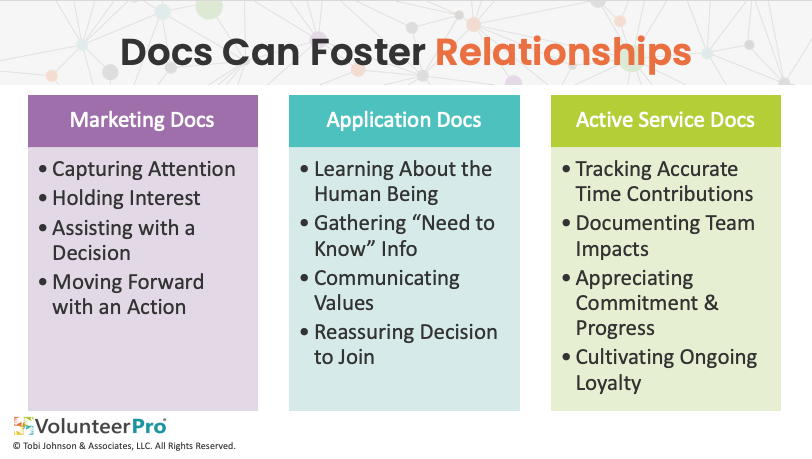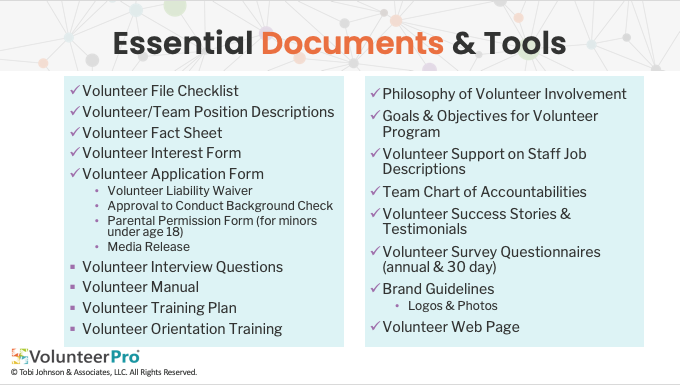 8 Volunteer Human Resources Tools Your Nonprofit Shouldn’t Live Without
8 Volunteer Human Resources Tools Your Nonprofit Shouldn’t Live Without
Most people understand that you’ll get more done if everyone is rowing in the same direction, however, it’s amazing how many organizations neglect to provide the key volunteer human resources documents that can point the way.
In the end, to find success volunteer organizations should put people before paperwork. However, it’s also important to give people some guidelines and support.
If approached with the right frame of mind, paperwork can build bridges and deepen relationships with people.
Build Trust Through Well-Designed Documents

The downside is that when it comes to volunteers, many organizations create extra forms and paperwork without being clear on why they are needed.
Below are a few good reasons to add a new document or form to support your volunteer programming. Use these as a preliminary checklist before you add another form for volunteers to sign.
Ask yourself if the proposed document serves any of these functions for paid staff or volunteers:
- Focuses attention on key reminders
- Increases clarity around roles and responsibilities
- Collects key data for program reporting and assessment
- Documents the active status and progress of volunteers throughout their lifecycle
- Demonstrates proof of due diligence and standard of care in the event of a mishap
- Manages risk by sharing liability or making inherent risks clear
If your proposed document doesn’t perform one of the functions above, consider whether it is really necessary.
8 Volunteer Human Resources Tools Every Nonprofit Needs
Below are eight tools that every nonprofit should have in place, why they are important, and a few tips on how to create them or what to include in them.
- Tool #1: Philosophy of Volunteer Involvement – One of the fundamental tools to better advocate for volunteer involvement across an agency is to establish an agency-side philosophy of volunteer involvement. It should communicate in no uncertain terms the value of volunteers a rationale for their use as a human resources strategy. This foundational statement is similar to your agency’s mission statement but focused on volunteers. As such, it must be understood and agreed upon by the top levels of management and can be used throughout your documents (position descriptions, volunteer handbook, training materials, your annual report, etc.).
- Tool #2: Volunteer Impact Statements – Having a set of statements that describe the results volunteers bring about can be handy, multi-purpose copy you can use in grant proposals, on your website, in volunteer recruitment copy, and volunteer position descriptions. An intended impact statement identifies both the beneficiaries of a nonprofit’s activities and the benefits volunteers will provide—that is, the change in behavior, knowledge, or change in the status quo that volunteers will affect.
- Tool #3: Volunteer Application Form – This form helps you capture needed data about potential volunteers, and it can also be a neat and tidy way to combine several functions into one format. Consider including the following in your application form, in addition to your general volunteer info — Volunteer Liability Waiver, Approval to Conduct Background Check. Parental Permission Form (for minors under age 18), Media Release, etc.
- Tool #4: Volunteer and Team Position Descriptions – Volunteers are looking for a higher purpose, and they want to be involved with something bigger than themselves. There’s no better place to make the case that your nonprofit is the place to achieve more than in a well-written volunteer position description. They should describe: Goals the Role, Impact of the Role, Duties and Responsibilities, Time Requirements, Location, Work Environment, Skills & Qualifications, Orientation & Training, Supervision & Support, Volunteer Perks, How to Apply. If you want to tap social proof (see below) include a volunteer testimonial or two.
- Tool #5: Volunteer Handbook – If you have volunteers or interns, they deserve to have the rules of the road spelled out for them in one, easy-to-access place. Volunteer handbooks are also part of your organization’s risk management plan. They help volunteers understand their rights and responsibilities to the organization and draw a clear connection between your mission and the reason volunteers are part of the mix.
- Tool #6: Desk Manuals – Not to be confused with employee manuals, desk manuals contain info about a specific staff or volunteer position. They include information about the step-by-step processes used to get tasks done. If you have individual people performing a specific job, the desk manual acts as a backup, if that person becomes ill or leaves the organization. It’s your insurance against the loss of valuable institutional knowledge.
- Tool #7: Communications Style Guide – Your organization may suffer from a split personality in terms of what you communicate to the public. Any inconsistencies undermine the effectiveness of your outreach and marketing efforts. Make sure you give your team clear guidelines about how to represent your organization visually and verbally. A communications style guide is a simple tool that keeps info about your logo, choice of language to use, etc. in one place that everyone can reference when they have questions.
- Tool # 8: Social Media Policy – Even if you’re not using social media often to get the word out, chances are some of your staff and volunteers are already sharing, chatting, posting, tweeting, etc. A social media policy gives common sense guidelines about what can be communicated about your organization using which channels. It should also detail what to do if something is inadvertently shared that shouldn’t have been. When these small crises are figured out ahead of time, you can address the issue with ease and move on.
Depending on your agency’s needs there may be additional documents that are vital to your success. Make sure you focus on creating solid tools that help both staff and volunteers navigate better and improve the experience for everyone.
Essential Volunteer Management Documents & Tools

Tips for Better Volunteer Human Resources Documents
Once you’ve decided to move forward with a new document (or refresh an old one), also consider how you can make them as engaging and as useful as possible.
Make sure you have a plan to ensure they are easily accessible to volunteers. If you can post them on a webpage for easy reference or download, that is ideal.
Also, maintain a consistent look and feel throughout your volunteer human resources documents. They should feel like a cohesive set with the same fonts, layouts, and colors. They should include your logo, as well.
Design does matter here. It helps to reduce cognitive burden and exponentially improve the user experience, thus increasing the chances your volunteers and employees will read and follow them.
 Also, don’t be afraid to repeat yourself – familiarity breeds … acceptance!
Also, don’t be afraid to repeat yourself – familiarity breeds … acceptance!
The mere exposure effect (or familiarity principle) suggests that we develop greater positive feelings toward a stimulus if we are repeatedly exposed to it. This is because through repeat exposures the new stimulus becomes more familiar and less threatening.
Familiarity does not breed contempt. In fact, it’s just the opposite. Repetition of messages is powerful because it increases processing fluency in the brain. The easier and faster something is to process, the better we feel about it, and we misattribute those good feelings to positivity about the message.
Common graphic elements might include “remember this” wrap-ups at the end of the sections in volunteer manuals, etc.
All volunteer communications platforms — recruitment materials, applications, training materials, manuals, etc. – should have the same look and feel, as well as messaging.
Do your volunteer human resources materials do the following:
- Use same terms & messaging across all platforms
- Use the same graphic elements (colors, text, icon types)
- Use similar wording style of section & sub-section headings
- Use common content elements (text blocks, buttons, icons)
IF not, make some updates. Don’t be afraid to repeat yourself!
You can also tap the power of social proof by including the “Voice of the Volunteer” wherever you can to convince volunteers to act.
What is social proof? If you have ever purchased a product, or visited a restaurant, or booked a hotel after a recommendation from somebody else, you’ve been influenced by social proof.
Psychologists have found that social proof, or what they call informational social influence, is a key driver of human behavior. As humans, we assume that the actions of others are correct, based on the frequency that they see the same actions performed repeatedly. Think 5-star ratings, long wait lines, and enthusiastic testimonials. These are all evidence of positive social proof that something is a great idea.
When it comes to your volunteer human resources documents, infusing them with quotes from volunteers that support or recommend compliance with a specific policy or are enthusiastic, in general, about their experience can help increase the chances that others will follow their peers.
What Volunteer Human Resources Document is Your Nonprofit Missing?
Which of the documents listed above are you missing from your current documents?
What are you most excited about creating next?







Leave A Comment